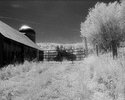Thanks, Pixophrenic. The scans look fine but no better than what I have seen from full C41 or full B&W. I suppose the key question is how much scan adjustment did the shop have to do. I am not a scanner but as I understand it, scanning can compensate for a negative that otherwise might be quite difficult to print in a darkroom. Not a problem for a hybrid person but not ideal for a darkroom printer. However as these are shop scans I suppose the answer is that you do not have the negatives to show us. Ideally a digital photo of the negative might give a good indication of how a bleach bypass process copes as this is the nub of your belief, I think.
A C41 bleach bypass process saves on bleach but not on C41 developer. To overcome the problems of C41 developer cost and short shelf life, I think you are hoping to achieve a home mix of C41 developer which can be made up on the spot and only in such quantities as are needed each time. Have I got this right? If so, where are you in terms of achieving a result here and what is the cost v over-the-counter C41 developer?
If your bleach bypass process is only as good as say full C41 or B&W process then other than a saving in cost of proprietary C41 developer ( assuming there is one) I am still unsure as to what the advantages of your process are.
pentaxuser
All of your assumptions are correct, pentaxuser. The result of using a BW developer on this film is an adequate negative for scanning, but not ideal for printing, although not impossible to print. The caveat is the very narrow range of densities achieved in a BW developer. So, the ambitious goal is to tinker with a color developer and produce a printable negative without using bleach-fix, some sort of an equivalent you get with Pyrocat HD, a silver and dye/stain image together. Such a negative will be too soft if bleach-fixed, but not impossible to handle with scanning. One cannot achieve this without a tight control of the developer's pH, and this is the thing that took quite some time to figure out how to handle in a home setting and on a budget.
Liquid developer storage, in itself, is not big news and have been achieved by AGFA kits, no longer available, and quite possibly the same in the current Cinestil C41 kit, where color developer comes in three liquid portions. This works, but I found along the way that when you peruse many of the the formulas listed in the patents and also somewhere else in this forum, you do not arrive at pH 10.0 automatically, and it is very critical to get a correct pH. So, yeah, factor in a cheap pH meter, which may not be necessary once the formula is worked out.
Frankly, at this time it is too early to ask about cost. And I am a low volume user, remember? Working out a formula definitely cost me more than a year's worth of kits. But cost for me is secondary to the ability to develop one film whenever I want to, and consistently well, and not to waste any remaining chemicals. I am not KRL but I have a distinct advantage of not having to chase the elusive goal of producing a developer that would suit all or most films on the market, just one. That is all I can say for now.





 and remembering
and remembering 
